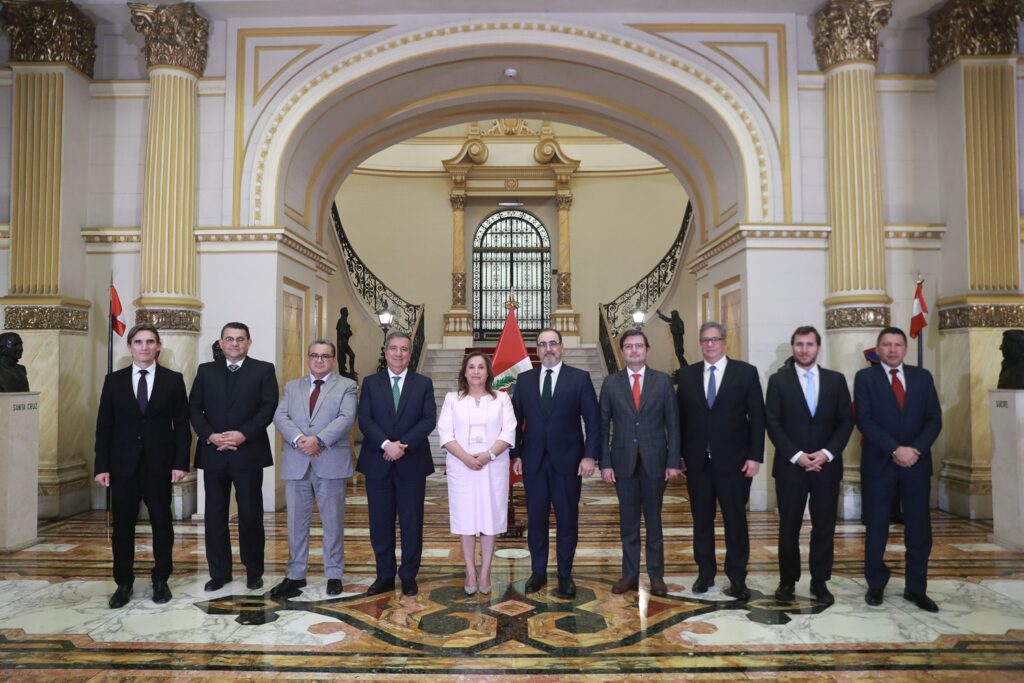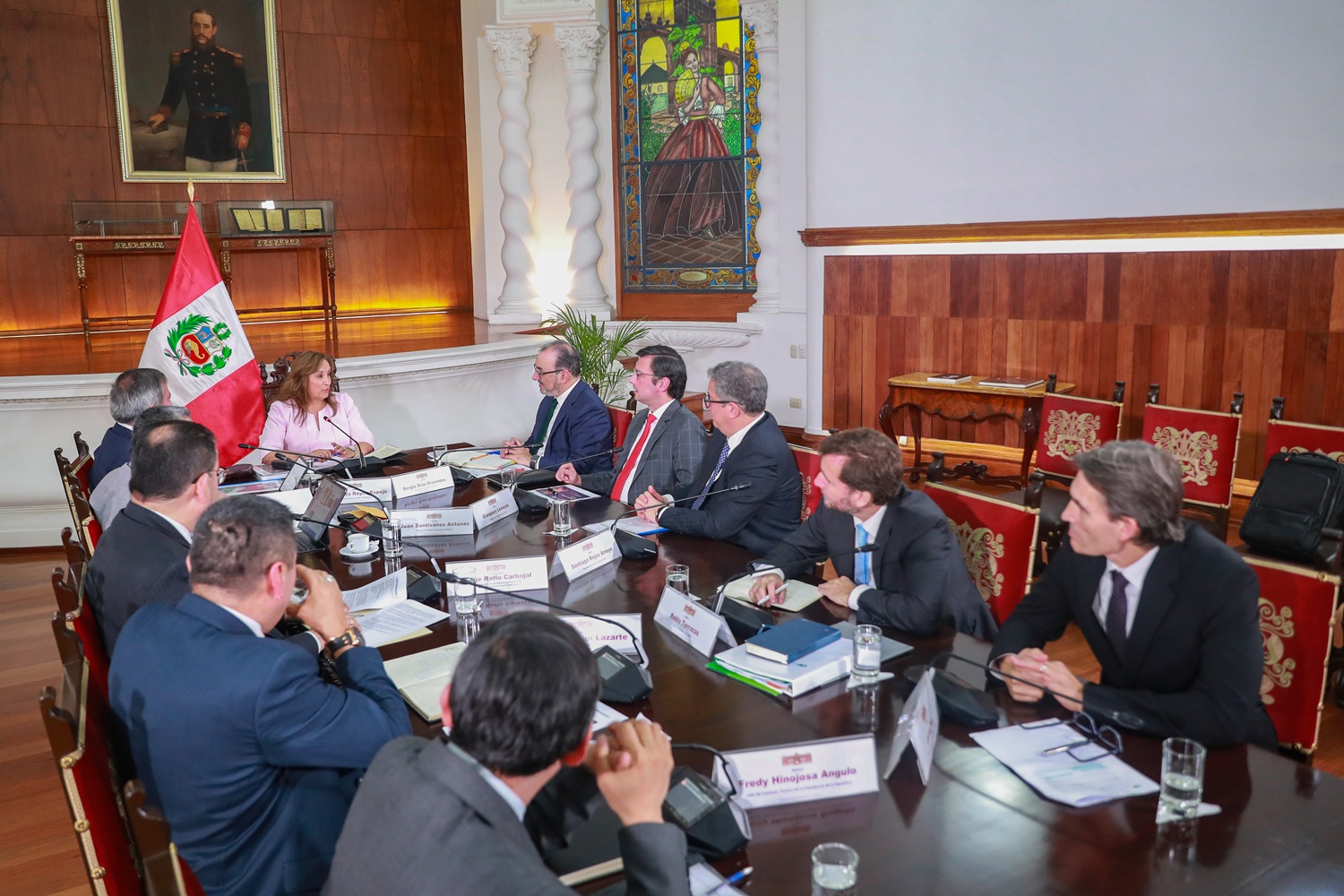Agencia Peruana de Noticias PRENSAPERU.PE https://prensaperu.pe/ Twitter: @prensaperupe La presidenta de la República del Perú, Dina Ercilia Boluarte Zegarra, lideró una trascendental audiencia con el Banco de Desarrollo de América Latina y el Caribe (CAF), consolidando un esfuerzo estratégico para la gestión de financiamiento destinado a la edificación de cinco centros penitenciarios de alta seguridad. Esta iniciativa busca abordar de manera frontal la crítica situación de hacinamiento carcelario y fortalecer la infraestructura de seguridad nacional ante el incremento de la criminalidad organizada.
La reunión, celebrada en el Palacio de Gobierno, contó con la participación del presidente ejecutivo de la CAF, Sergio Díaz-Granados, lo que subraya la relevancia y el respaldo multilateral a este proyecto. Durante el encuentro, la mandataria detalló que los nuevos establecimientos penitenciarios se ubicarán estratégicamente en las regiones de Cusco, Pasco, La Libertad, Arequipa y Huacho. La inversión proyectada para esta ambiciosa obra asciende a aproximadamente 800 millones de dólares, marcando un hito en la política penitenciaria del país.
La jefa de Estado enfatizó la urgencia de esta medida, señalando que “lamentablemente, ¿hace cuántos años no se construye una cárcel en el país?”. Este déficit infraestructural, sumado al fenómeno de la delincuencia transnacional que afecta a toda la región, ha exacerbado el grave hacinamiento en los penales peruanos. La construcción de estos cinco centros penitenciarios se perfila como una solución estructural para mitigar esta problemática, mejorando las condiciones de reclusión y la clasificación de los internos.
En el marco de la planificación, se destacó el avanzado estado del proyecto del penal de Colquepata, en Cusco. Este solo requiere la suscripción del contrato, un paso previsto para los próximos días. Una vez formalizado, se procederá con la elaboración del expediente técnico y la convocatoria para su ejecución, estimada para el mes de enero del próximo año, lo que demuestra un cronograma de implementación acelerado.
Particularmente, el penal de Huacho se proyecta como una infraestructura de gran envergadura, con capacidad para albergar a aproximadamente 16,000 internos, lo que lo convierte en uno de los complejos penitenciarios más grandes del país. Adicionalmente, se contempla la construcción de un penal exclusivo para sentenciados de alta peligrosidad, diseñado para custodiar a 10,000 personas privadas de su libertad, un componente crucial para la seguridad interna y externa. Otros dos establecimientos se encuentran en fase avanzada de gestión, completando el paquete inicial de proyectos.
La presidenta Boluarte subrayó que, más allá de la contención, el objetivo central de esta inversión es garantizar la resocialización efectiva de los internos. “La idea es que, cuando salgan en libertad, no vuelvan a reincidir en el delito, sino que puedan estudiar, capacitarse y encontrar un empleo digno para no ser rechazados por la sociedad. Si desde el Gobierno partimos de esa convicción, ellos encontrarán razones para cambiar”, manifestó. Esta visión integral busca transformar los centros penitenciarios en espacios de rehabilitación y reinserción social, contribuyendo a la seguridad ciudadana a largo plazo.
La trascendencia de la cita se vio reforzada por la presencia de figuras clave del gabinete, incluyendo al ministro de Economía y Finanzas, Raúl Pérez Reyes Espejo, y al ministro de Justicia y Derechos Humanos, Juan José Santiváñez Antúnez, junto a altos directivos de la CAF, evidenciando el compromiso interinstitucional y la coordinación necesaria para la materialización de estos proyectos de infraestructura crítica.
CONCLUSIONES
1.- Inversión Estratégica en Seguridad y Derechos Humanos.
La construcción de estos cinco penales de alta seguridad representa una inversión crítica y estratégica para el Perú, abordando simultáneamente el grave problema de hacinamiento carcelario y la necesidad de fortalecer la seguridad nacional ante la creciente complejidad de la criminalidad. Este esfuerzo no solo busca mejorar las condiciones de reclusión, sino también optimizar la gestión penitenciaria y la clasificación de internos, contribuyendo a la estabilidad social y al respeto de los derechos humanos dentro del sistema.
2.- Colaboración Multilateral y Gubernamental para el Desarrollo de Infraestructura.
La participación del Banco de Desarrollo de América Latina y el Caribe (CAF) como socio financiero, junto con la coordinación interministerial de Economía y Justicia, subraya la complejidad y la magnitud de estos proyectos. Esta alianza estratégica es fundamental para movilizar los recursos necesarios y asegurar la viabilidad técnica y financiera de obras de infraestructura de gran escala, sentando un precedente para futuras colaboraciones en el desarrollo nacional.
3.- Hacia una Política Penitenciaria Integral con Enfoque en Resocialización.
Más allá de la expansión de la capacidad carcelaria, la iniciativa enfatiza un objetivo fundamental de resocialización de los internos. Al integrar programas de estudio, capacitación y preparación para el empleo digno, el gobierno peruano busca transformar el sistema penitenciario en una herramienta efectiva para la reinserción social, rompiendo el ciclo de la reincidencia y promoviendo la construcción de una sociedad más segura y con mayores oportunidades para todos.
Fuente: Agencia Peruana de Noticias PRENSAPERU.PE https://prensaperu.pe/ Twitter: @prensaperupe

English Translation
Peru and CAF promote US$800 million investment in five high-security prisons to combat overcrowding and crime.
Peruvian News Agency PRENSAPERU.PE https://prensaperu.pe/ Twitter: @prensaperupe The President of the Republic of Peru, Dina Ercilia Boluarte Zegarra, led a momentous meeting with the Development Bank of Latin America and the Caribbean (CAF), consolidating a strategic effort to secure financing for the construction of five high-security prisons. This initiative seeks to directly address the critical situation of prison overcrowding and strengthen the national security infrastructure in the face of the rise in organized crime.
The meeting, held at the Government Palace, was attended by CAF Executive President Sergio Díaz-Granados, underscoring the relevance and multilateral support for this project. During the meeting, the president explained that the new penitentiary facilities will be strategically located in the regions of Cusco, Pasco, La Libertad, Arequipa, and Huacho. The projected investment for this ambitious project amounts to approximately $800 million, marking a milestone in the country’s penitentiary policy.
The head of state emphasized the urgency of this measure, noting that “unfortunately, how many years has it been since a prison was built in the country?” This infrastructural deficit, coupled with the phenomenon of transnational crime affecting the entire region, has exacerbated the severe overcrowding in Peruvian prisons. The construction of these five penitentiary centers is emerging as a structural solution to mitigate this problem, improving prison conditions and inmate classification.
Within the framework of the planning, the advanced status of the Colquepata prison project in Cusco was highlighted. This only requires the signing of the contract, a step planned for the coming days. Once formalized, the technical file will be prepared and the call for proposals issued, estimated for January of next year, demonstrating an accelerated implementation schedule.
Specifically, the Huacho prison is projected to be a large-scale facility, with a capacity to house approximately 16,000 inmates, making it one of the largest prison complexes in the country. Additionally, the construction of a prison exclusively for highly dangerous prisoners is planned, designed to house 10,000 inmates, a crucial component for internal and external security. Two other facilities are in the advanced stages of development, completing the initial project package.
President Boluarte emphasized that, beyond containment, the central objective of this investment is to guarantee the effective resocialization of inmates. “The idea is that, when they are released, they will not reoffend, but rather that they can study, train, and find decent employment so as not to be rejected by society. If we, as the Government, start from this conviction, they will find reasons to change,” she stated. This comprehensive vision seeks to transform penitentiary centers into spaces for rehabilitation and social reintegration, contributing to long-term citizen security.
The significance of the meeting was reinforced by the presence of key cabinet figures, including the Minister of Economy and Finance, Raúl Pérez Reyes Espejo, and the Minister of Justice and Human Rights, Juan José Santiváñez Antúnez, along with senior CAF officials, demonstrating the inter-institutional commitment and coordination necessary for the realization of these critical infrastructure projects.
CONCLUSIONS
1.- Strategic Investment in Security and Human Rights.
The construction of these five high-security prisons represents a critical and strategic investment for Peru, simultaneously addressing the serious problem of prison overcrowding and the need to strengthen national security in the face of the growing complexity of crime. This effort not only seeks to improve prison conditions but also to optimize prison management and inmate classification, contributing to social stability and respect for human rights within the system.
2.- Multilateral and Governmental Collaboration for Infrastructure Development.
The participation of the Development Bank of Latin America and the Caribbean (CAF) as a financial partner, along with the inter-ministerial coordination of Economy and Justice, underscores the complexity and magnitude of these projects. This strategic alliance is essential to mobilize the necessary resources and ensure the technical and financial viability of large-scale infrastructure projects, setting a precedent for future collaborations in national development.
3.- Toward a Comprehensive Penitentiary Policy with a Focus on Resocialization.
Beyond expanding prison capacity, the initiative emphasizes a fundamental objective of resocialization for inmates. By integrating study, training, and decent employment preparation programs, the Peruvian government seeks to transform the penitentiary system into an effective tool for social reintegration, breaking the cycle of recidivism and promoting the construction of a safer society with greater opportunities for all.
Source: Peruvian News Agency PRENSAPERU.PE https://prensaperu.pe/ Twitter: @prensaperupe
